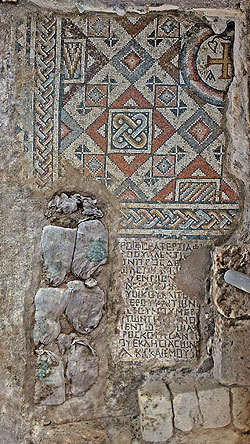In the Israel Antiquities Authority’s excavations in Tiberias a Byzantine church was exposed that is paved with polychrome mosaics decorated with geometric patterns and dedicatory inscriptions. Appearing in one of the inscriptions is the text: “Our Lord, protect the soul of your servant…” (Our Lord=Jesus). The discovery, which was uncovered in the heart of the ancient Jewish city, refutes the theory that the Jews of Tiberias prevented the Christians from establishing a church in the middle of their neighborhood.
In excavations that were carried out by the Israel Antiquities Authority in Tiberias impressive and unique finds were uncovered that shed light on the history of the ancient city. The excavations were conducted over the course of the last three months at the request of Mekorot, as part of a project that involves the installation of a sewage pipeline and the transfer of the waste water treatment facility from Tiberias to the southern part of the Sea of Galilee.
The finds that were exposed date from the founding of Tiberias in the first century CE until the eleventh century, when the city was abandoned due to an earthquake, wars and dire economic and security conditions. In the lower part of the city, a Byzantine church (from the fourth-fifth centuries CE) was exposed that is paved with magnificent polychrome mosaics decorated with geometric patterns and crosses. Three dedicatory inscriptions written in ancient Greek are incorporated in the mosaics. In one of the inscriptions, which were deciphered by Dr. Leah Di Signi of the Hebrew University of Jerusalem, is the line: “Our Lord, protect the soul of your servant…” (Our Lord=Jesus). One of the mosaics is adorned with a medallion in which there is a large cross flanked by the letters alpha and omega, which are one of the monograms for Jesus (alpha to omega meaning from A to Z in Greek). The church’s remains were discovered adjacent to ancient public buildings among them a basilica, bathhouse, streets and shops that were exposed at the site in the past. Dr. Moshe Hartal and Edna Amos, the directors of the excavation on behalf of the Israel Antiquities Authority, stated that this is the most ancient church to be uncovered in Tiberias and the only one that has been found in the center of the city.

The mosaic with the dedicatory inscriptions
In addition, the remains of a Jewish neighborhood that dates to the tenth-eleventh centuries were discovered in the excavations. These remains extend up to the foot of the cliff in the high part of the city, in an area that was probably residential in nature. “The discovery of the remains of the church in the middle of the ancient city, like that of the Jewish neighborhood and the magnificent city that existed in Tiberias more than one thousand years ago, greatly contributes to our understanding of the town planning, its scope and it structures”, archaeologists on behalf of the Israel Antiquities Authority said. The discovery of the church in the heart of the Jewish quarter disproves the theory that the Jews prevented the Christians from establishing prayer halls in the middle of the city”, they added.
In the Holiday Inn hotel’s parking lot, in the southern part of the excavation, buildings were uncovered that were replete with a wealth of impressive ceramic vessels that date to the Early Islamic period (eighth-eleventh centuries CE) and installations for the manufacture of glass and pottery vessels. These finds show that in this period the settlement of Hammat was included within the domain of the city of Tiberias, which had grown and expanded beyond the Byzantine city walls that had previously separated it from Hammat. In addition a settlement was discovered that dates to the Early Bronze Age (from 5,000 years ago) thereby attesting to the fact that the region of Tiberias was inhabited in periods earlier than those mentioned in the historical sources.
Additional Articles ...